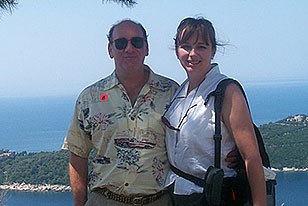Color Correction
Taking Color Out, Putting Color In
Speaker: Deke McClelland
Color and luminance are the two main ingredients of a photographic image. And even though they are as thoroughly blended as flour and water in a mixer bowl, Photoshop lets you separate these ingredients cleanly, as if the twain had never met. The result is that you can mix any of several black-and-white variations, infuse an image with color, and modify different ranges of colors independently to get just the effect you want. In this session you'll learn:
- Why every digital photograph starts out as a black-and-white image.
- Why every raw photograph produced by a digital camera and Camera Raw is color.
- How to blend a custom monochrome image using the improved Channel Mixer.
- How to gain even more control over the process using the new Black & White command.
- How to achieve the highest degree of control possible using Camera Raw 4.
- Ways to balance gray values with the Curves command.
- When it can be useful to add spot colors to an image using the arcane Duotone command.
- How to edit ranges of colors independently using Hue/Saturation and Camera Raw.
- How to colorize an image with Split Toning and the often overlooked Gradient Map.
Correcting Everything in Camera Raw
Speaker: Deke McClelland
Photoshop's color correction features are a powerful but random bunch. Randomly organized, randomly implemented, randomly suited to photographic images. Do you start with Levels? Can you apply Hue/Saturation and Variations, or should just one suffice? Should you always use adjustment layers or are there times when flat adjustments are better? There are a lot of theories out there, but one thing's for sure: Photoshop isn't going to help you. It just lumps all the color commands in the Adjustment submenu and leave chance to sort them out.
Compare that to Camera Raw in which every option is prioritized, every modification is dynamic, and the original image is never harmed. It is in many regards like having Lightroom built into Photoshop. But unlike Lightroom, it ships with Photoshop for free. And in Photoshop CS3, Camera Raw 4 (or ACR4 as many call it) can open any image, raw, TIFF, or JPEG. You'll learn how to:
- Open any image in ACR4.
- Navigate inside the ACR interface.
- Correct temperature and tint.
- Adjust exposure, brightness, and contrast.
- Boost the Saturation and Vibrance of an image.
- Use the best Curves function in Photoshop.
- Selectively correct Hue, Saturation, and Luminance.
- Convert an image to black-and-white.
- Apply spot corrections with the retouch tool.
- Save presets and batch-process a day's shoot—all without opening a single image in Photoshop.
- Open a Camera Raw image as a smart object, so you can return to ACR anytime you want.












